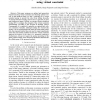102 search results - page 11 / 21 » Trajectory Constraints in Qualitative Simulation |
JCNS
2002
13 years 7 months ago
2002
A generalized version of the integrate-and-fire model is presented that qualitatively reproduces firing rates and membrane trajectories of motoneurons. The description is based on ...
IADIS
2004
13 years 9 months ago
2004
We have developed models of how strategies are constructed and retained as male and female high school and university students gain experience in solving online qualitative chemic...
IROS
2008
IEEE
14 years 2 months ago
2008
IEEE
— This paper proposes an optimal gait generation framework using virtual constraint and learning optimal control. In this method, firstly, we add a constraint by a virtual poten...
IROS
2009
IEEE
14 years 2 months ago
2009
IEEE
– This paper presents a predictive gain scheduler for path tracking control in a networked control system with variable delay. The controller uses the plant model to predict futu...
GRAPHICSINTERFACE
2011
12 years 11 months ago
2011
Most of existing crowd simulation algorithms focus on the moving trajectories of individual agents, while collective group formations are often roughly learned from video examples...

